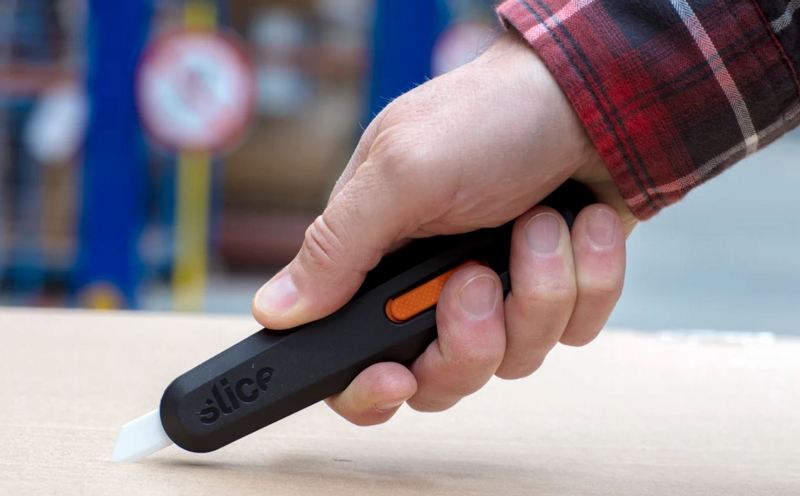We independently evaluate all recommended products and services. Any products or services put forward appear in no particular order. If you click on links we provide, we may receive compensation.
We all know safety matters when handling a knife. Whether you’re cutting through thick tape on a parcel or whittling a chunk of wood into your latest masterpiece, a good knife helps reduce your risk of nasty accidents. Sure, knowing how to hold and position a cutting tool properly is part of the battle. But one with a healthy number of safety features can keep your hands laceration-free, too.
And that’s where the humble safety knife comes in. The best ones on the market are designed to maximize safety and minimize danger. But if you’re picturing a flimsy tool with a dull blade that couldn’t even cut a sheet of wet paper, don’t. There are plenty of knives that combine efficiency and safety to protect you while you cut different materials.
Below, we’ll look at some of the various types available, what makes them safer, why they’re more efficient and some key factors to keep in mind when shopping for one.
What Safety Knives are Available?
Ever injured yourself while handling a knife? You’re not alone. According to the Bureau of Labor Statistics, “cuts, lacerations, or punctures” accounted for 15,380 injuries at work in 2019. Whether you use a knife in your job or not, the message is clear: Many people are injured by knives on a regular basis.

We have no way of knowing what type of knives those 15,000-plus people used or what caused their accident. Maybe some of them were untrained and inexperienced. Maybe some were talking on the phone or to a coworker while cutting. But in any case, a safety knife could have helped to prevent at least some of those injuries.
Whether you carry a knife in your toolbox on the job or in your backpack for hiking, there’s a model out there for you. You can choose from an extensive catalog of safety knives to suit your work duties, outdoor activities, or indoor hobbies.
A set of safety knives demonstrates the diversity on offer, from folding knives for everyday carry to precision blades for cutting intricate shapes.
What Makes Safety Knives So Safe and Efficient?
Any cutting tool is only worth carrying in your pocket or toolbelt if it does its job. No matter how safe it is, you’ll probably ditch a knife that doesn’t cut as well as you need it to and try another instead. That’s why the best manufacturers of safety knives don’t sacrifice functionality or efficiency to reduce risks. Instead, they incorporate innovative features and durable materials to boost performance while maximizing safety.
And how do they do that? What features and materials are we talking about?
Here are some of the things you need to know if you want to add a safety knife to your collection.
Different Retraction Options to Prevent Accidents
Retracting a blade after use is essential to avoid those blink-and-you’ll-miss-them accidents. We all know how they go. You put the knife down, forget the blade is still exposed, and cut your finger when you pick it up again. Or you hand the tool to someone else without putting the blade away, and remember just before they cut their palm.
All knife manufacturers offer a mix of retraction options to cater to a broad range of customers. You might have so many years as a knife aficionado under your belt that a manual tool, with multiple positions, works best for you. Or you may swear by auto-retractable knives because you’ve nicked your fingers too many times with manual tools.
Whichever type you prefer, there’s a safety knife for you. Most knives with a replaceable blade have a manual or auto-retractable handle. With a manual model, you can fix the blade in one of multiple locked positions to suit the task at hand. You’ll need most of the blade to cut a thick carpet, for instance, but just the tip should be enough for paper or fine cardboard.
An auto-retractable tool pulls the blade back into the handle when you finish your cut. That makes it easier to stay safe and protect other people who want to use the knife after you.
Finger Loops for a More Secure Grip
A good grip is a must for cutting safely and efficiently. You could cut yourself, ruin a piece of material, or even injure someone else if your hand slips. A poorly designed handle can make it harder to maintain a solid grip, especially if you work up a little sweat.
Fortunately, good safety knives have comfortable handles designed to help you hold on tight, and some even include a finger loop to keep a firmer grip. That can make a big difference when you’re hot and need precision cutting to achieve the neatest results.
Ambidextrous Designs to Suit Lefties and Righties
More than 13% of people in the U.S. are left-handed. And they’d probably agree that the world sometimes feels designed for the right-handed, with everything from ergonomic scissors to tin openers causing issues for lefties.
If you’re left-handed and struggle to find a knife that feels just right in your hands, a safety knife could be the solution you’re looking for. Some are designed for ambidextrous function; there’s a feature to switch the blade orientation to work for you, whichever hand you favor.
But that’s not necessary for every safety knife. A number of models are ambidextrous as standard, so you won’t need to change the blade’s position for comfortable cutting.
Why is an ambidextrous design important? The knife should be safer to handle and cut more effectively when it’s in your best hand. You’ll be at less risk of injuring yourself and making a mistake, too, whether you’re trimming branches for firewood or adjusting your clothes. And you’ll boost your efficiency as a result.
Non-Metal Blades Last Longer and Don’t Rust
When you think of the average blade, you may think of sharp steel blades or ceramic blades. However, some safety blades are made with 100% zirconium oxide instead of the other two materials. Here’s how they differ.
Firstly, zirconium oxide blades are significantly harder and if used correctly last 11 times longer than conventional blades, so there’s less need to change or replace them. That means you’ll save money and face less risk of cutting yourself when you handle the blades.
Secondly, zirconium oxide doesn’t rust. You’ll appreciate that if you’ve spent good time and money switching blades sooner than you expected to because they’ve started to rust. And you can rinse and wash the blades whenever you need to without worrying about ruining them. That’s terrific if you use your knife to cut wood coated with mold and mildew, or have to clean paint from your blades if you’re a crafter.
As a result, your knife will stay in top condition and maintain its effectiveness longer.
No Need for Tools When Changing Blades
Some safety knives with replaceable blades have a no-tool changing feature when it’s time to fit a new one. That makes it quicker and easier to insert a new blade; you don’t need to unscrew the back of the handle or struggle with intricate components. To swap blades, just fully extend the knife, lock it in place, push a release button, and gently pull the blade free. You’ll be able to insert the replacement and start using the knife again in no time.
That’s a significant advantage when time is a factor. If changing the blade is a hassle, you might be reluctant to do it even when the blade gets duller and less effective. And you’ll end up feeling like you need to press harder when cutting, which can make it more likely that you’ll hurt yourself if you’re not careful.
But when a safety knife has a tool-free change function, it’s simpler to fit a fresh blade and go back to optimal cutting performance.
A Few Factors to Keep in Mind Before You Buy
Of course, safety knives aren’t for everyone but if you think they fit your needs here are some points to mull over when you check out your options:
- Narrow down how you’ll most likely use the knife: Whether you need a knife for crafting, do-it-yourself projects, or as an unpacking tool, find a safety knife that has features for what you need instead of trying to make a general knife work for everything.
- Check the safety features: Is the knife auto-retractable or manual? Does it have smart retraction (retracts when there is no pressure on the lever or an object to be cut)? How do you replace the blades, or do you? Is it safe and easy to carry around (ex. in your pocket or a belt hook)?
- Review the overall design: Safety knives are available in many different styles, including folding and mini cutter formats. A handle’s design, shape, and grip will have a huge impact on how you use it. For instance, a knife with an ergonomic handle might be best if you’re using it on a repeated basis.
Investing in a safety knife could help to reduce the likelihood of injuring yourself while cutting, but still ensure you have a practical tool for different applications.
The best examples effectively combine safety and efficiency to offer maximum bang for your buck. You can enhance your safety and equip yourself with a quality tool that’ll come in handy for everything from building a campfire to taking up an old carpet.
Whether you need a safety knife for work, leisure, or both, take your time to weigh your options before you pick one. You might just wonder how you managed with a traditional knife for so long.





